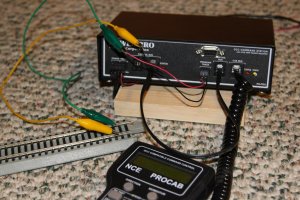goscrewyourselves
I'm the one
Are you on the programming track or on the main?
I only use direct and ops programming myself, but Digitrax defaults to paged mode. To change the modes use ONE of the following:
Step 3a: For direct mode (programming track), press Program twice more so that "Pg" (looks like "P6" actually) in the display changes to "Ph" and then to "Pd"
Step 3a: For operations mode (programming on the main), press Program three more times so that it changes from "Pg" to "Ph" to "Pd" and finally to "Po". Note that if you are programming on the main, you will have to select the CURRENT decoder address before entering program mode (LOCO, Select #, ENTER as steps 2a, 2b and 2c if you will). You can then proceed with the other steps.
Maybe that'll fix things up.
Mike,
Because I can't seem to get a stand alone programming track to work, I have been doing everything on the main. I'll try again and see what happens and thanks for the instructions - hopefully this time.
Should follow MikeOwnby's directions but also all you have to do is put loco on program track and get to Pg mode and once in Pg mode if you simply hit enter it should read the address of the loco and give you its present address and you can then re address it to what ever you want. Digitrax has a real learning curve and takes lots of practice to get to know the ins and outs. Wait until you decide you want to change a horn or bell etc , then it gets to be fun. You may find this shortcuts card handy.View attachment 45118
Thanks for the "cheat card, haven't seen one of them until now. Changing bells whistles etc - your kidding me right! Not a hope in hell of me even thinking about doing that let alone trying it. Think I'll just pass on the fun, for the time being


